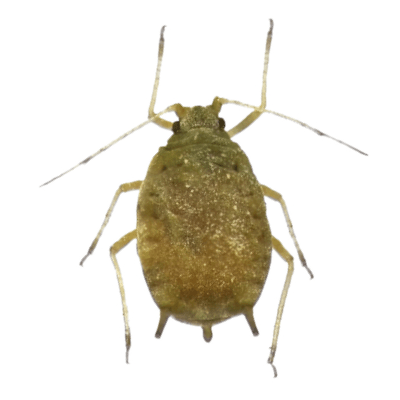
Color: Aphids may be Pink, brown, black, whitish or greenish.
Size: Aphids are 1/16” to 1/8” pear like insects that may be winged or wingless
Generally in the whirl of the plant, whirls and pre-emergent tassels, on the heads of cereal grains, leaf whorls and tightly rolled leaves, undersurfaces of leaves on the lower aspects of the plant, On the young terminal growth tissues of plants, leaves, blooms and stems as well, on young shoots and terminal leaves, on stems and young developing leaves early in the season
They usually have two cornicles, or ‘tailpipes’, that protrude off the upper surface of the abdomen. Aphids secrete excess sap or ‘honeydew’, from the anus as they feed, which leaves a sticky residue on plant surfaces. This residue indicates aphid presence in fields.
Aphids feed by sucking plant juices, usually from the tender, succulent parts of plants.
They may damage a plant by sucking plant juices that directly weaken plant, injecting toxins from their saliva that cause curled leaves and malformations, or transmitting diseases that cause secondary plant injury.
- Before planting vegetables, check surrounding areas for sources of aphids and remove them. Aphids often build up on weeds, moving onto crop seedlings after they emerge. Check transplants for aphids and remove them before planting.
- Aphids are attracted to plants that look weak that may be lacking some minerals it really invites them in to destroy them. So it’s always important to make sure your plants are healthy give them enough Iron and Potassium.
- High levels of nitrogen fertilizer favor aphid reproduction. Never use more nitrogen than necessary. Use less soluble forms of nitrogen and apply it in small portions throughout the season rather than all at once.
- The most popular and most natural aphid control method of course is to invite all the lady bugs possible over to your plants to eat those annoying aphids. Buy some live lady bugs which can you can buy from your local nursery.
- Where aphid populations are localized on a few curled leaves or new shoots, the best control may be to prune these areas out and dispose of them. In large trees, some aphids thrive in the dense inner canopy; pruning these areas out can make the habitat less suitable.
Manufacturer Recommended Products And Treatment For Aphids Control
Pests need food, water, and shelter. Often the problem may be solved just by removing these key items. Before even thinking about chemical pest control, it is important to be aware of
| Conducive Condition | Recommendation | |
| 1 | Tree branches on house | Keep tree branches away from house to reduce pest access |
| 2 | Firewood next to foundation | Keep firewood away from house to reduce pest harborage |
| 3 | Debris on crawlspace/next to foundation | Remove wood debris to reduce termite ha rborage area |
| 4 | Excessive plant cover, stump, etc. | Providing spacing between plant cover and structure |
| 5 | Soil above the foundation Ii ne | Keep soil below top of foundation to reduce harbo rage areas |
| 6 | Wood-to-ground contact | Keep soil from touching wood to eliminate termite access |
| 7 | Debris on roof/full gutter | Keep gutter & roof free of debris to reduce insect harborage |
| 8 | Standi ng water near/under structure | Eli minate standing water to reduce pest harbo rage |
| 9 | Mo isture problem under structure | Increase ventilation to reduce pest harbo rage area |
| 10 | Openi ngs at plumbi ng & electronics | Seal opening to reduce pest access |
| 11 | Excessive gaps at windows/doors | Seal gaps to reduce pest access |
| 12 | Lea ky plumb ing fixtures | Repair to reduce moisture for pests |
| 13 | Keep garbage cans covered | Covered to reduce attraction of insects of vertebrate pests |
| 14 | Mo isture damage wood | Repair rotten or damaged wood to reduce insect harborage |
| 15 | Grocery bags stored improperly | Seal paper sacks in containers to reduce i nsect ha rborage areas |
| 16 | Pet food unsealed or left out | Keep pet food in sealed containers and unavailable to pests |
| 17 | Excessive storage conditions | Keep storage areas uncluttered and manageable |
| 18 | Debris below kick plates | Remove kick plates to reduce rodent harborage |
2 products



